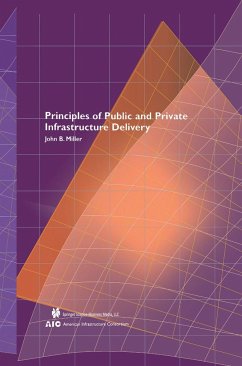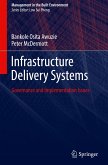Essential to anyone involved in the planning, design, construction, operation or finance of infrastructure assets, this innovative work puts project delivery, finance, and operation together in a practical new formulation of how both public and private owners can better manage their entire collection of infrastructure facilities.
Principles of Public and Private Infrastructure Delivery traces the history of infrastructure development and finance in the United States, and meticulously ties America's historical success in infrastructure to the simultaneous use of Design-Bid- Build, Design-Build, Design-Build-Operate, and Design-Build-Finance-Operate to deliver both public and private infrastructure collections. This historical background provides the basis for a new, integrated strategy for managing infrastructure assets in the 21st century.
Principles of Public and Private Infrastructure Delivery provides the logic and practical tools that public and private decision-makers need to make better strategic choices in the application of scarce resources to infrastructure facilities. New tools are presented that permit simple comparisons of different project delivery and finance strategies. Practical approaches are provided that allow owners to quickly compare capital program alternatives for entire collections of infrastructure facilities. Practical legislative strategies for organizing the delivery of public infrastructure are presented and described.
Principles of Public and Private Infrastructure Delivery provides a practical framework that owners can apply to implement a competitive infrastructure strategy and a principled framework that private sector firms can use to effectively reposition themselves in this changing market. It puts infrastructure asset management in an entirely new and more productive light, and establishes a new paradigm for steady improvement in the quality and cost performance of public and private infrastructure networks.
Audience: This book will be an essential reference tool for infrastructure managers throughout the public and private sectors, including: Public Works Officials; Corporate Officials Responsible for Asset Management; State Legislators and Executive Officials; State Agencies and Regional Authorities Responsible for Transportation, Water Supply and Treatment; City Mayors, Town Managers, and Other Local Officials; Private Infrastructure Developers and Operators; Procurement and Project Counsel; Design-Builders; Constructors; Design Professionals; Management Consultants; Program Managers; and Financial Institutions.
Principles of Public and Private Infrastructure Delivery traces the history of infrastructure development and finance in the United States, and meticulously ties America's historical success in infrastructure to the simultaneous use of Design-Bid- Build, Design-Build, Design-Build-Operate, and Design-Build-Finance-Operate to deliver both public and private infrastructure collections. This historical background provides the basis for a new, integrated strategy for managing infrastructure assets in the 21st century.
Principles of Public and Private Infrastructure Delivery provides the logic and practical tools that public and private decision-makers need to make better strategic choices in the application of scarce resources to infrastructure facilities. New tools are presented that permit simple comparisons of different project delivery and finance strategies. Practical approaches are provided that allow owners to quickly compare capital program alternatives for entire collections of infrastructure facilities. Practical legislative strategies for organizing the delivery of public infrastructure are presented and described.
Principles of Public and Private Infrastructure Delivery provides a practical framework that owners can apply to implement a competitive infrastructure strategy and a principled framework that private sector firms can use to effectively reposition themselves in this changing market. It puts infrastructure asset management in an entirely new and more productive light, and establishes a new paradigm for steady improvement in the quality and cost performance of public and private infrastructure networks.
Audience: This book will be an essential reference tool for infrastructure managers throughout the public and private sectors, including: Public Works Officials; Corporate Officials Responsible for Asset Management; State Legislators and Executive Officials; State Agencies and Regional Authorities Responsible for Transportation, Water Supply and Treatment; City Mayors, Town Managers, and Other Local Officials; Private Infrastructure Developers and Operators; Procurement and Project Counsel; Design-Builders; Constructors; Design Professionals; Management Consultants; Program Managers; and Financial Institutions.
`Miller's insight into some of the newer infrastructure experiences will be of broad interest to many in the construction industry. The content of the endnotes and the appendices are so comprehensive that one is hard-pressed to imagine any other resource that contains this type of information in an organized, convenient formatPart of what makes Miller's case so persuasive is the presentation of the material. The book's organizational style is as unique as its content.'
Mike Loulakis, Design Build Magazine
Mike Loulakis, Design Build Magazine
`Miller's insight into some of the newer infrastructure experiences will be of broad interest to many in the construction industry. The content of the endnotes and the appendices are so comprehensive that one is hard-pressed to imagine any other resource that contains this type of information in an organized, convenient formatPart of what makes Miller's case so persuasive is the presentation of the material. The book's organizational style is as unique as its content.' Mike Loulakis, Design Build Magazine









